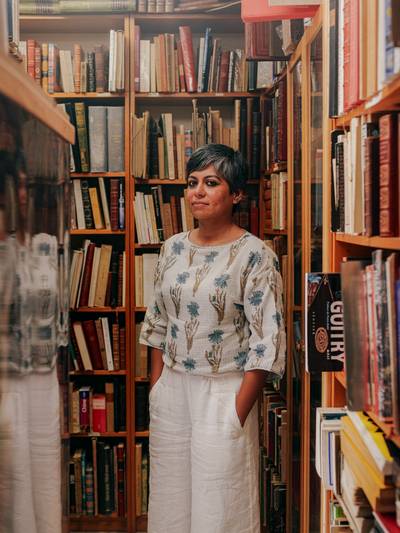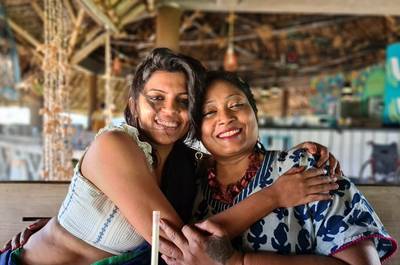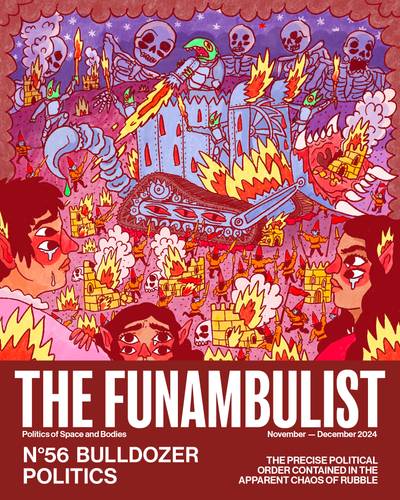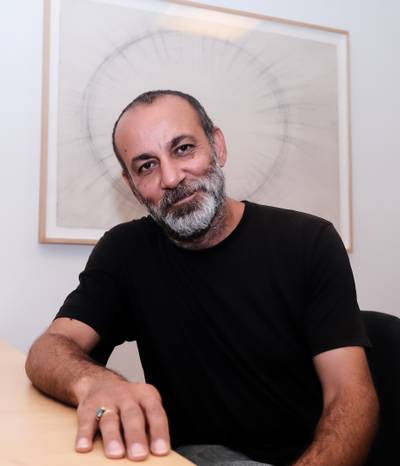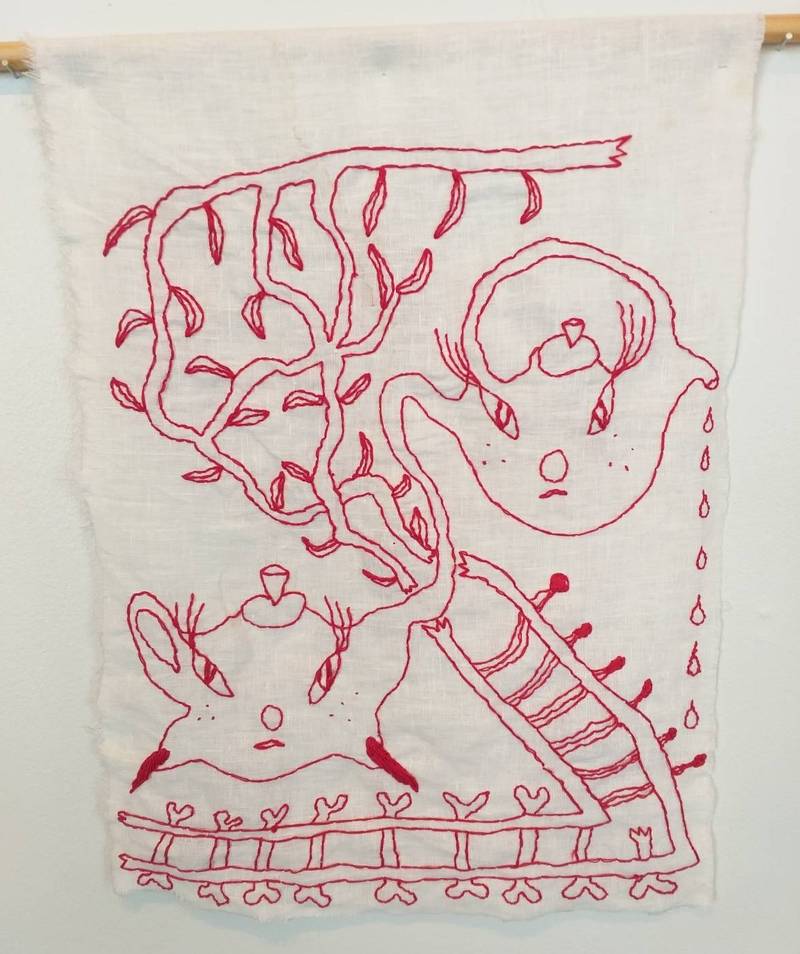

puusta pitkälle, 2021 / Karelian käspaikka, traditional decorated linen.
Vilu Puttonen is a student of social and economic history and is interested in care, feminist economics and queer pasts. They are doing art things and tattoos and always searching for traces and friendships.
I am talking to KaffeochBulla on a windy July afternoon. We are drinking coffee and ginger beer and having one of our many art talks except today we are getting it on tape. They double-check if it’s recording. Luckily, my phone recorder has been proven to be reliable. We are sitting in Loukko’s currently empty terrace and peeking at KaffeochBulla’s work through the window as a reminder and a guide for our conversation. My description of them would be an artist, an artisan, a friend. They are someone who explores the world in many ways, crawls around and makes marks on walls and skin and other surfaces. They carry a layer of mystery around them but are surprisingly easy to approach.
VILU: I want to hear about your work that’s showing now in Loukko but I was thinking that we should also talk about community and how to show your work to others because I think that you pay a lot of attention to that: where to find a community, how it may look like, and what it means for an artist to relate to other artists.
KAFFEOCHBULLA: To be honest, I’ve spent a lot of my life quite alienated and lonely. Because of this, I feel that it’s important for my art to be in touch with reality either through the materials or the process. By this, I mean working with my hands and materials of the Earth. I also dream of connecting with people and it feels so precious when it happens. I’m trying not to talk in negations but I don’t resonate with empty intellectual art. My art has to be connected to the surrounding world and its materials and friends in a humble way – and hopefully in a way that can also be radical and spread solidarity.
The way I learned to connect with KaffeochBulla was mainly through art and usually in a very straightforward manner. They would hand me zines, prints, stickers, earrings or clothes upon meeting, and always ask what I’ve been doing or experimenting with. It has always felt vulnerable in a nice way and that these exchanges of art, thoughts and treasures weave little webs of support and excitement for one another.
I feel like the way you gift people with zines and other artworks of yours are also very reflective of your practice: it is very humble and human.
Definitely. I think that art is made to be shared and especially in a 3D-IRL-Offline-form. My background is in underground circles where everything is a treasure hunt of sorts: finding people’s artworks and zines. This hunt binds you to the world in a different way than digital art could ever do and pushes you to a different experience and mentality. Like, you have to make an effort sometimes. I want to share my gifts because I know how meaningful it was, for myself, to get my hands on these underground zines, which I then read with glowing eyes and wondered who might’ve written them. I guess I want to spark the same feeling of magic in others too because that magic took me out of really dark places and gave me a sense of belonging and a purpose.
KaffeochBulla’s work is currently part of Loukko’s summer exhibition called Doing other – Different or alternative ways and acts of doing. The theme was described on the website as a possibility to ”discuss experiences of othering when one is put into the position of being other, or one’s art, actions, identity is considered atypical. We encouraged the artists to think of art that can reshape, dream or offer a different future for the current art field in form of manifestos, curious questions, gentle suggestions or sharp observations.” I thought it was very fitting for KaffeochBulla’s practice.
I guess my connection has always been there in some way but I feel that, recently, it has been discussed more in the media. Not even my mom knew that Karelians are their people, separate from the Finnish. A lot has disappeared through forced Finnishization so I’m going through this constant process of building a home that maybe never existed.
I think it’s very fitting you were chosen for this exhibition. “Doing other” feels very you.
For the exhibition, I wanted to explore my Karelianness by doing käspaikka in another way that they are traditionally made. I thought a lot about intergenerational trauma and how I could break it through telling stories and working with my hands. Through picture making, I’m able to be curious and heal my inner child. There has to be positive and active nihilism in my art, also, when exploring difficult subjects… Rather than wallowing in them, haha.
Can you tell me what käspaikka is?
Käspaikka is a Karelian decorated hand towel. Over time, they became so beautiful that you couldn’t wipe your hands on them anymore. You often hang them with icons. They are made by cross-stitching, with a technique that has stayed the same for years. This is the first time I’ve made them myself and you can see that I’m still learning. But it’s good to dare to be curious and playful with new things. Or old things.
During the working process, I had to sit down for hours and hours with something I didn’t know much about. I had to stay still and think about these things a lot: how to deal with intergenerational unspoken trauma. And normally I’m in this constant state of alert, staying busy all the time. So, sitting down for hours and thinking about these things – it was a lot harder than I thought.
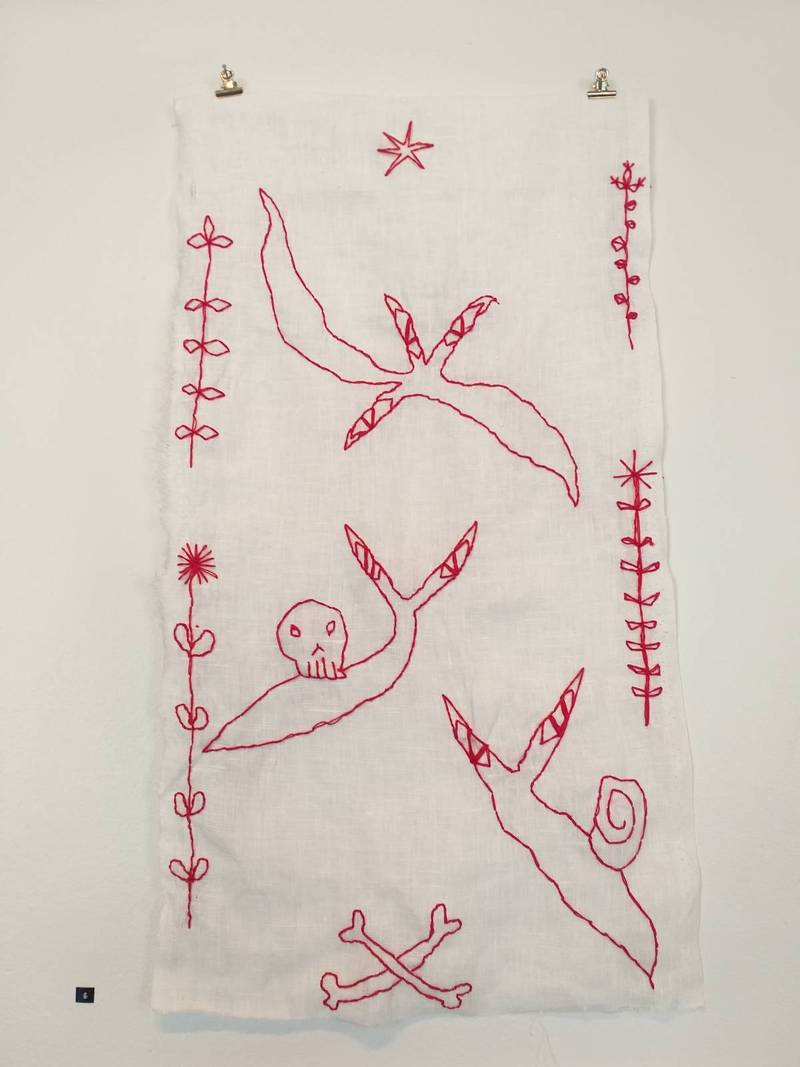

How did you begin to connect with your Karelianness?
I guess my connection has always been there in some way but I feel that, recently, it has been discussed more in the media. Not even my mom knew that Karelians are their people, separate from the Finnish. A lot has disappeared through forced Finnishization so I’m going through this constant process of building a home that maybe never existed.
All the time, in my art practice, I’m building these worlds. A lot of my work is based on naive, fantastic dreaming, and it’s one of the few places I get to be myself and create what I want. So, it’s world building. I’ve been thinking that, without the war, I would probably be living in an area that’s part of Russia today. So, it’s like the snails in the käspaikka: they don’t have homes but they have found it in each other. I think it’s a beautiful and hopeful thought.
I think so too. In your other käspaikka, there’s this railway that is turning into a tree, and this image fascinated me.
Yeah… the symbolism is pretty rough in it haha. Cute but dangerous. The railway is about “radottaminen” (the word is derived from the Finnish word for railway and it means addiction/substance abuse). It’s about alcoholism that is passed down to different generations. Some members of my family have gone to prison or died because of these things. I almost died too. But then there are these sturdy teapots that can interrupt the railway. So, it’s not an eternal sentence. By sticking together, they can create this world tree (elämänpuu) which is also a strong symbol in Karelian culture.
They show me a world tree tattoo on their arm.
Here it grows. It’s a symbol of life. Some of my friends have it too. Some are still here and some are not but I hold them close to me always.
That’s beautiful. I like how the sturdy teapots also hold this sympathetic value of everyday life. They make me think of guests and treating visitors.
But that’s super important in Karelian culture: to be hospitable and take care of people! Every time you have guests you should serve them food and spoil the fuck out of them. These käspaikkas are also items of everyday life: hand towels. And how I’ve learned art making is that it has to serve some kind of a “function”. I’ve learned a lot from design and making everyday life objects beautiful. I come from a family of carpenters and weavers which has probably influenced this. But I’m trying to learn that art can just “be” on its own too.
KaffeochBulla goes to the bathroom and I start to read this text that they wrote for the exhibition catalogue. I liked it a lot and decided we should talk about it (which we sort of did and sort of not). I thought the text to be an important part of this work since it’s showing the process and showing the artist behind the work – it’s like giving clues. I hoped the exhibition visitors also remembered to pick up the catalogue to find the clues. So, after KaffeochBulla returned we reread the text together and I asked them to tell me about it.
with needle and thread staying still and present
i give up the survival mode
Been stuck in the cycle
with these hands i take myself into the land i’ve never been in, the soil i’ve never touched
but it’s been there inside of me my whole life
i translate into a language i have little idea how to speak yet
after all – mistakes were done on purpose to käspaikka because “only god was perfect”
it’s dyed with mushrooms and such
it smells like snails and dark wool
i wanted to show these works to my sick granma but due to an eye surgery she couldn’t see well
enough. later on, she appeared in my dream and told me “everything was going to be okay”
i transcend – i transform – make it finally possible
victimization into active nihilism
despair and intergenerational unresolved grief into rage
force that’s driving me somewhere
alienation into complicity
addiction into tree of life
because power of telling stories – like generations before me is
that i get to choose what words come out – i can do differently
I thought a lot while doing my comics project, about the power of storytelling and how people tell stories in Karelian culture and pass on traditions orally. And I was thinking about how to tell stories with your hands and through the pictures you make.
In Karelian culture, there are these weeping women (itkijänaiset) who have had a strong role in building a sense of community on important occasions such as funerals or weddings. They have been the backbones of the community and channels for spiritual processes.
I’ve been wondering whether it’s me now who’s the black sheep of the family, always bringing up difficult subjects. And what’s the point even, for me to try and break these intergenerational traumas if I won’t be having children of my own. But of course, I’m not living in a vacuum, hopefully, and this will affect other people’s lives and realities. So, I guess these pictures are channelling something unspoken. Unspoken topics still exist in our bodies and our minds.
Bringing up hard topics and breaking intergenerational curses is a shitty job but somebody’s gotta do it, I guess. I have come to realize that many of these processes are very long and there’s no detox smoothie you can drink and be fine with it. There’s no “mythical past” I can return to, either. I need to create and understand what it means to me to be Karelian right here and now.
Bringing up hard topics and breaking intergenerational curses is a shitty job but somebody’s gotta do it, I guess. I have come to realize that many of these processes are very long and there’s no detox smoothie you can drink and be fine with it. There’s no “mythical past” I can return to, either. I need to create and understand what it means to me to be Karelian right here and now.
What does it mean to you?
Hahaa, next question. Well, I guess it’s an ongoing process… Trying to connect the dots on a map I’ve never seen before. It also means embracing folk art. To be honest, sometimes I have no idea what I’m doing when so much of the culture and language has died. But then, sometimes when I’m having my darkest moments, my ancestors appear to me in my dreams and tell me that it’s all fine.
It’s nice you have this guidance. I guess, most of the time figuring out something is a messy, confusing process. But that’s also why it’s interesting.
I’m interested in complex realities. And capitalism, in so many ways, fools us with promises of instant fix and shiny products – also in art. And because I have internalized this idea of commercialization, I need to be in touch with my spiritual side: to fight this alienation. Destroying systems of oppression through art is also a process, and often a slow one. I’m an impatient person so I’d like to just smash something but unfortunately, it doesn’t always work that way.
Unfortunately, it doesn’t. How is it with different methods? Does your process change when approaching these questions through tattooing, cross-stitching or wood carving and so on?
The different methods guide you to different worlds. If I burn pictures on wooden boards, I have to go dumpster diving and if I make käspaikkas, I have to stay still for hours. This all gets lost if we focus only on the finished work. Especially if it’s seen through a smartphone screen.
Tattooing, on the other hand, is very intimate because it’s decorating and reclaiming your own body. The more tattoos I have, the more I feel at home in my body. I feel more empowered.
It’s like decorating your snail shell.
Exactly! It’s super interesting to explore where different materials can take you and what they can teach you. I’ve learned to make the best out of the few resources I’ve had which is also a very humbling process. If there’s a will there’s a way… I just learned last year that people get art grants – like I could’ve never imagined this while poking friends with needle and ink in a squat, haha.
A lot of my art is also tied to location. I go out there and face the ugly reality. For me, rolling around in dirt and slime or crawling under barbed wires is part of the process. I often make work that’s caught in the moment. It doesn’t have to be perfect technically because I care more about the feelings it provokes. This guides my work a lot, ties it to the world and its materials.
And these material realities already provide this connection to the world so you don’t have to look for the link in the same way. I feel that there’s this theme of home that is very present in your art: Decorating your body, your home, with tattoos or decorating domestic items and clothing. And then it all connects to the larger world and society and how to navigate in this larger home. So I guess, for me, your art is also a lot about defining and taking space.
Yes, I haven’t thought about it that way but it makes sense. I’m lucky that there are many artisans in my family because from them I have gained this curious, down to earth approach towards the world. When you’re a survivor, you easily go into this autopilot mode and there’s no room left for curiosity. It’s all just coping. Then, to learn how to approach the world by thinking about what kind of magic you can create in it, can transform the way you see yourself and the possibilities you have. You can take up space and define it on your own terms. Through creating art, I reject the role of the victim.
Yeah, I’ve been thinking about this a lot: that the world is often kind of horrible, and it makes me frustrated that there could be only certain people that can define the ways of being for all of us. There’s so much magic and joy and play, and then having it restricted in this way feels unfair so we should fight against it in all possible ways.
Exactly. Since I was small, I have learned, from other people, that there’s something wrong with the way I’m making art. That I’m just really bad at it. Or not bad but that I do things the wrong way, like make a straight line across a labyrinth, have “ugly” handwriting or draw weird things. It made me feel ashamed and that there’s something wrong with my inner world.
Also, having a long history of trauma and oppression caused me to lose my connection to my magic and inner world of fantasy. I was way too busy coping and I thought for a long time that these things vanished away for good. But in many ways art was the only thing for me when I was in really dark places like going through substance abuse.
I’ve lost way too many years that I’m now trying to take back. Grief is a driving force for me. I think it’s a powerful and beautiful thought that the line between fantasy and reality can blur through art. It’s like a healing process. And I think it’s a beautiful thought that no matter how shitty the world is and how much you go through, it won’t break you wholly. Your magic may get buried underneath something but it can’t be destroyed.
I have had experiences of creating art in a culture where you have to be the best and you can’t show vulnerability. And it gets very lonely if you can’t make mistakes or reach out for help.
***It is. These feelings can be very isolating and it’s one step to allow yourself to do something in the “wrong” way despite what you’ve learned but that it takes a lot of courage to share it with others too. What do you think has helped you in this? ***
It always gives me a spark of joy when I see some kids spraying silly images on a wall just out of the pure joy of creation. Or when I find some old washed away rusty DIY sculpture or gnarly ceramic creatures with crooked eyes from the flea market, it makes me think: “Damn, they made it this far so maybe I can make it too!” Embracing nerdy things like old horror video games or emo poetry makes me feel that someone else also appreciates these weird and wild imperfections. That I’m not alone in this world.
I have had experiences of creating art in a culture where you have to be the best and you can’t show vulnerability. And it gets very lonely if you can’t make mistakes or reach out for help. Because of these experiences, I started to define my art through negations: “Well, at least I’m not like them” which I later realized to be very isolating. If I’m always “not like the other girls” how would I be able to make connections with others and find a community?
How is it, finding a community?
So hard sometimes… Especially when you don’t have institutional support you have to step out of your cave and trust other people and trust your process. And you have to ask for help and be vulnerable because it’s the only way to form intimate relationships. That’s why I try to stay humble and uplift my friends I want to create complex stories to which to relate in radical ways. I want to share secrets, liberate and heal. Maybe that’s also what queer means to me: the creative destruction of every oppressive thing and loving as much as you can. I don’t know… I want to create queer art that burns it all to ashes while we wildly dance together. Maybe it won’t happen but at least I tried.
